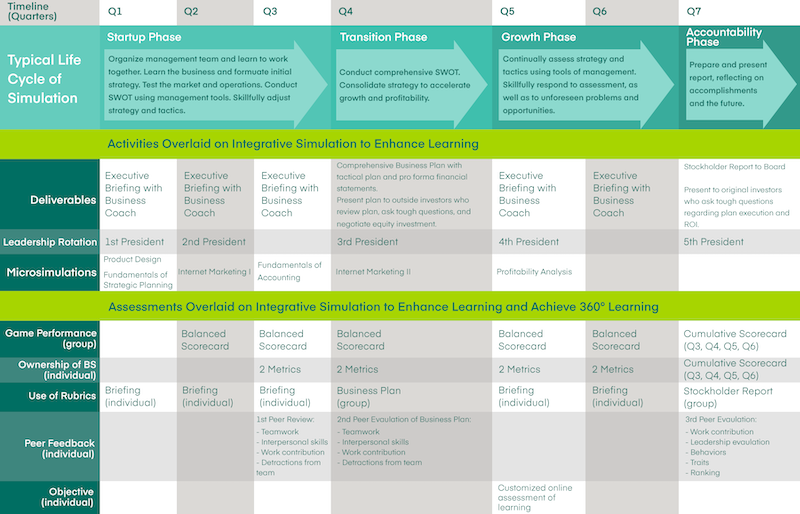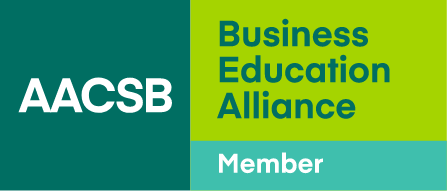Simulations Spark Engagement and Real Learning
- By participating in simulations, students have opportunities to practice and refine their business skills in meaningful ways.
- As students compete against classmates, the friendly rivalry drives higher engagement and deeper learning.
- Simulations are most powerful when students work in teams, receive coaching from instructors, and produce deliverables such as business plans.
Knowledge is not skill. There is a wide gap between knowing what to do and being able to do it. Whether someone is attempting to play a sport, master an art, or become a savvy business manager, the only way to transform knowledge into skill is through practice.
One of the best ways for students to gain practice is through simulations that allow them to apply and refine their knowledge. A highly engaging simulation can provide students with a holistic vision of business and the knowledge and skills they need to become career-ready.
In the context of a simulation, people go through four stages of learning: They assess their current situation, reflect on how to apply their knowledge, decide the best course of action, and act on their decisions. As part of a continuous learning cycle, they update their knowledge and begin the whole process again, developing their skills through repeated practice. This cycle is very similar to the four-part model of learning styles that David Kolb described in 1984.
Business faculty can design simulation games that engage and inspire students and maximize their emotional involvement and their learning. Even a single course can be structured to provide meaningful learner-to-learner, learner-to-faculty, and learner-to-industry professional engagement.
Simulations present concepts in ways that are more visual, intuitive, and contextualized than lectures, readings, and cases. By providing students with challenges to solve, simulations gamify the acquisition of knowledge. This heightens student attention and makes the learning process fun.
Gamification for Maximum Engagement
Most simulations are disciplinary-specific rather than cross-functional. The shorter ones might run only 15 minutes and focus on a single difficult concept that students find easiest to grasp through an immersive experience. Longer ones might last for hours or even days and include multiple interconnected constructs that students must coordinate if they are to perform their jobs well. These simulations help develop the participants’ skills by enabling them to alter multiple elements within the game in a coordinated manner while tracking a dashboard of performance indicators.
In a special category of simulations labeled as “serious games,” participants compete against classmates. During head-to-head competition, participants must continually upgrade their skills and develop new ones that they were never formally taught so they can respond to challenges from competitors who make smart, surprising, and responsive decisions. As students focus on outperforming their classmates in a friendly rivalry, their desire to succeed drives higher engagement and they become totally immersed in the learning process.
Some simulations can teach valuable lessons about managing the societal impact of the firm or the state of the world today. Other simulations allow students to gain hands-on managerial experience as they run their own ventures in gamelike environments. Students practice teamwork, leadership, critical thinking, problem solving, analytical thinking, decision making, management by the numbers, and cross-functional integration. When students make realistic business decisions and immediately see the results of their actions, they gain business acumen and do a better job of internalizing core business principles. They also learn to balance competing interests as they attempt to deliver substantial value to all their stakeholders.
A Sample Simulation

Simulation exercises allow instructors to provide students with a complete microcosm of a business experience, as shown by the timeline of this simulation from the University of Tennessee.
It is possible to build a simulation exercise that is a complete microcosm of a business experience. Within the parameters of the simulation, students can learn to create customer value, manage scarce resources, plan future tactics, estimate cash flows, execute plans, pitch to outside investors, be accountable to investors, and deal with the unknowable and the unexpected.
At the University of Tennessee in Knoxville, we have 30 years of experience in developing and delivering simulation-based learning. Over the years, we have created several value-added activities and assessments that further enhance knowledge and skill development. Our learning platform is Marketplace Simulations, for which I am the author, but most comprehensive simulations will deliver similar results.
We have determined that student learning is most energized when simulations include teamwork, leadership development, executive briefings, business plans, stockholder reports, assessment metrics, and instructors who act as coaches. Based on these elements, we have built seven core beliefs about how to run simulations.
1. Teams Are Best for Learning
Depending on the simulation, students can play either as members of a team or as individuals who must manage an entire firm or department. We have found that there are more learning opportunities when students work in teams.
First, students not only practice business concepts—they also develop teamwork skills. They learn how to make decisions as a group, resolve disagreements, and handle conflicts. Because each student takes on a certain set of responsibilities within the simulated company, all teammates discover how their business decisions affect different parts of the firm.
Second, they enhance their leadership skills, because they all must take the lead within their areas of responsibility. They must pitch ideas to the team, justify their reasoning, learn to accommodate suggestions and opposing viewpoints, motivate others to follow their lead, and allow others to lead when it’s appropriate. They acquire deep learning in all aspects of their ventures while developing their critical thinking and communication skills.
Finally, when students work in teams, the workload is more manageable, which results in better performance.
2. Leadership Roles Are for Everyone
Military academies have learned that a good way to develop leadership among the ranks is to rotate each person through a variety of leadership roles and provide feedback on performance. Simulations also can develop leadership qualities by making sure each student takes a turn serving as the president of an organization.
A good way to develop leadership is to rotate each person through a variety of leadership roles and provide feedback on performance.
In the Marketplace Simulation we use at Tennessee, a business goes through five distinct phases: startup, test market, pitch competition, growth, and final accounting. In each phase, a different student can serve as president. The president’s job is to manage the schedules, assign tasks, orchestrate the work, and monitor overall performance. At the end of the exercise, leaders can receive peer feedback on their performance.
While natural leaders will step forward without prodding, reluctant leaders need to be encouraged—perhaps not even given the option of backing out. Most students find they can lead a team if they are required to do so.
3. Briefings Replicate Corporate Meetings
Our simulations usually include executive briefings in which the instructor meets with teams online or in person. These sessions are similar to the experiences students will have in the workplace when they meet with investors or senior managers. In these sessions, students individually and collectively report on their performance, make situational assessments, justify their tactical decisions, and describe their plans for the future.
The briefings have a second, extremely valuable purpose: They are the best venue for instructors to act as coaches who motivate students, evaluate individual efforts, provide targeted instruction, and get to know students better. Briefings allow instructors to monitor their students’ thought processes, skills, and overall business acumen, while challenging their thinking.
4. Business Plans Develop Financial Acumen
In most games, students are given a chance to develop business plans, prepare pro forma financial statements, and make presentations to outside judges.
By presenting and defending their business plans, students learn a critical skill—how to ask for money. Whether they are making the financial request of a venture capitalist or an executive committee, business leaders must know how to create a credible plan, project believable results, and convince investors that their team can accomplish stated goals while dealing with the surprises that will inevitably arise.
5. Stockholder Reports Ensure Accountability
It’s essential that, at the end of the simulation, teams are held accountable for their decisions. At Tennessee, we do this through a stockholder report in which outside judges act as members of a board of directors or an executive committee. These outside evaluators are eager to discover whether student teams earned a return on their investments and why the plan went well or badly. They might ask questions about performance, strategy, tactics, and competition, as well as the business logic the teams used to make decisions.
While students find it uncomfortable to report outcomes that fall short of projections, they learn how important it is to be able to justify their decisions.
The stockholder report has obvious parallels in the business world, where managers need to account for the resources they have been given and the promises they have made. While students find it uncomfortable to report outcomes that fall short of projections, they learn how important it is to be able to justify their decisions.
6. Assessment Leads to Learning
Simulations embody the old business axiom “What is measured gets managed.” Students will focus most on the activities that will be graded. Only the best students will go beyond what is required. Although assessments are important for grading and program evaluation, they are more important for focusing students’ attention and energy on what they need to learn.
Therefore, we have developed assessments for all our value-added activities. At the team level, we evaluate the group’s overall performance, its ability to raise money from investors, and its ability to critique its own performance and decision-making capabilities. At the individual level, we assess a student’s analytical skills, situational awareness, teamwork and interpersonal skills, and leadership skills. The assessments not only provide us with the basis for grading, but also help us meet AACSB’s learning goals.
7. Instructors Should Be Business Coaches
Instructors can follow many paths when using simulations. In large introductory classes, instructors might let the simulation run on autopilot, trusting that the gamification aspects of the exercise will engage students and drive them toward the finish line. In smaller classes, instructors might take the more interesting approach of building the simulation into lectures and classroom discussions. When instructors expound on lessons that teams are learning in the game, students sit up and take notice.
For high-level simulations and classes, instructors also can take on the role of business coaches who provide hands-on instruction. At our school, we have found that changing the instructor’s role to that of business coach literally has been a game changer in helping students become career-ready. When faculty act as mentors and developmental coaches, students try harder, think and act smarter, and achieve more.
At some schools, instructors take an opposing view, believing it’s better to allow students to solve their own problems and win or lose on their own merit. But at Tennessee, we believe every student and every team deserves help in developing knowledge, talents, and skills. We might set a high bar, but we help as many students as possible get over it. We want to make sure all our students are confident and prepared to lead their own businesses.
Engage, Challenge, Inspire, Transform
Too often, our educational system follows a piecemeal approach in which students learn about many aspects of business but never have a holistic experience that pulls all the elements together. Students are like blind people who have touched many parts of the business elephant, but until they know what an elephant looks like, they can’t understand how it functions as a dominant player in the jungle of business. A full-enterprise simulation can provide that knowledge.
To paraphrase Thomas Edison, business is 1 percent inspiration and 99 percent perspiration. A well-run simulation can make that 99 percent much more productive and enjoyable for the students. And it can enable professors to engage, challenge, inspire, and transform students into better people and more successful managers.
Join a cohort of business school faculty to learn how you can create engaging and interactive learning experiences at our Teaching With Business Simulation Games course.






